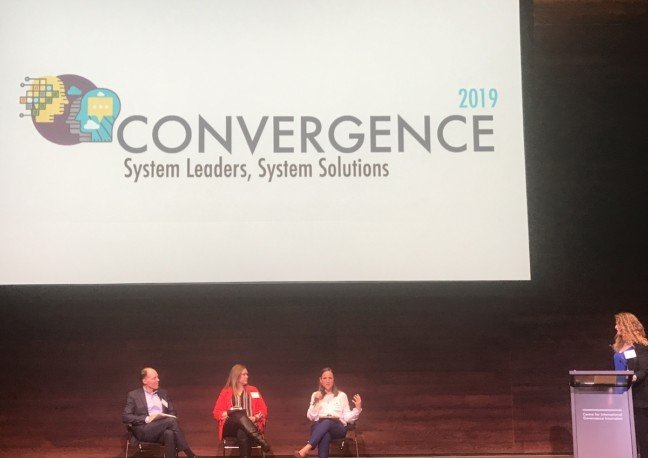It was a courageous step to see one of the LHINs stepping up to run the #Convergence19 conference on system thinking at a time when changes towards Ontario Health may cause the majority to be focussing internally. We need bold, decisive leadership to prompt system-level thinking in healthcare.
Here we explore the superb #Convergence19 half-day session run by Waterloo-Wellington Local Health Integration network at the award-winning CIGI (Centre for International Governance in Innovation).
Be Bold. Be Decisive. Be Leaders
Waterloo Region Police Chief Bryan M. Larkin opened this #Convergent19 session calling all of us to be bold, decisive, leaders. Leading in the age of disruption and beyond the noise.
“The future is here. It is just not evenly distributed,” noted Georgina Black
Advisory Board insights
Vidal Seegobin from The Advisory Board Company shared meticulous research with international perspectives during his session on The Essentials of Integration – Global Lessons in Building Systems of Care. He described the move to population health. This is remarkably apt at a time when Ontario Health replaces the LHIN structure. The Advisory Board work shows how 15-35% of patients named the Rising-Risk Patients represented the most significant necessity for system-wide resource planning so that they do not join the 5% of patient in the high-risk patients with multiple comorbidities. Each patient needs the right care, at the right time, delivered in the right place.
- Assembling systems from independent providers/entities is a political exercise – In most jurisdictions, the move towards system assembly has been voluntary. While many providers come together based on their shared geography, it’s their
longer standing relationships that drive the speed and sustainability of their system. - “Coalitions of the willing excel at reporting and struggle at making decisions – The true currency of governance of integrated systems is decision making. At the outset, these cooperatives excel at meeting and sharing information. They struggle, whoever, to make decisions–especially ones that impact the collective.
- Don’t overlook the power of inducements or ‘sweeteners’. – Aligning objectives and partner behaviour is a challenge even when we share the same incentive. Consider how extending resources and capabilities can make it easier for partners to do what we’re asking of them.
- All of the best population health managers address as far ‘upstream’ as possible – Invariably that leads to a focus on the non-clinical factors that influence health outcomes. For most this requires both the funding and operations to connect the pieces as effectively as possible.
“A significant issue is how you engage people towards what is best for the system, even if it isn’t immediately connected to their
organisation ,” David Evans, CEO Telford and Wrekin Clinical Commission Group, UK
Manchester Model of Care
The international experience was illustrated through a new model of care implemented in Manchester, UK. Greater Manchester Mayor, Andy Burnham provided an inspiring video describing how they are trying to engender their place-based personalized and integrated care to address those most likely to fall like the homeless. Read his full speech from 2018 here Place-Based Integration and Whole Person Support: the Greater Manchester Model
“We are developing a new model for public service delivery based on person, place and prevention.”
“As we have built this model, a constant theme has emerged at our Reform Board: names, not numbers. Focus on the people in the community who most need our support, rather than the statistics that public services are forced to monitor by their Whitehall departments, and build integrated solutions around them.”
“We
recognise that change will not come overnight. But, if we all commit to the Greater Manchester Model for the long haul, I am confident that, over the decade, we can make Greater Manchester healthier, happier and an even better place to live than it already is.”
System Leaders, Systsem Slutions
Among Seegobin’s international examples, the Rotherham Social Prescribing experiment has demonstrated a 42% reduction in emergency room visits and fewer non-elective inpatient episodes. This emphasized his message around systemness design based on distinct and staged benefits of working as a system in both journey and outcome. Read this paper by Blenko MW et al from the June 2010 HBR on The Decision-Driven Organization.
- Operational Benefits
- Clinical Benefits
- Structural Benefits
- Transformational Benefits
CEO of YMCA Cambridge, Kitchener-Waterloo Peter Sweeney’s indigenous land acknowledgement about truths was exceptional and compelled each of us to act. Summing up the day, CEO of WWLHIN, Bruce Lauckner said we are putting humanity in healthcare.
“Truly grateful to be part of a community where innovation is not an afterthought for the humanity of what health and social services at their core,” reflects Bruce Lauckner.
Thank you to the speakers, CIGI, WWLHIN and United Way Waterloo Region for bringing more than 200 leaders together for this look at transformation innovation in health.

